Summary
Project goal is to develop a fully-instrumented version of the tension-compression test, to enable measurement of the Bauschinger Effect in sheet metal, and to be able to measure the ratio of kinematic to isotropic hardening.
Description
The inability to reliably predict the mechanical behavior of new automotive alloys during forming has generated strong demand for more advanced constitutive relationships and property data necessary to calibrate them. There is a particular need for models that incorporate combined kinematic and isotropic hardening in the sheet. The primary objective for these models is to increase the understanding of the complex loading around draw-beads, where calibration tests must include full-reversal of the loading (i.e., to probe both sides of the yield surface during plastic deformation). The test developed to generate the necessary property data subjects a tensile sheet specimen to a fully reversed uniaxial load cycle. Uniaxial loading produces a homogeneous stress/strain distribution in the gauge area of the specimen thereby enabling a better assessment of the springback that will occur during forming. However, uniaxial compression of thin sheets results in buckling unless the out-of-plane motion is prevented, e.g by implementing anti-buckling guides on the lateral faces. While many designs for this test have been developed, proper assessment of the lateral forces required to prevent buckling during compression and the ensuing friction remains a considerable measurement challenge. In addition to the design of the testing fixture, the specimen also has to be designed to work properly with the fixture for the material being tested.

Our approach to address these problems uses a unique testing setup in conjunction with optimization of the specimen geometry. Our testing setup prevents buckling by using two opposing pnuematic actuators in force control with independent load cells to simultaneously apply and measure the forces on the anti-buckling guides. The principal advantage of this approach is that the force applied on the anti-buckling guides can be kept constant while adjusting to specimen thickness changes. The friction is minimized with lubricants and is monitored using the difference in force between the upper and lower longitudinal load cells. Strain is measured using stereo-DIC on the thickness edge of the specimen. A verified finite element model is used to optimize the specimen design to ensure prevention of various buckling modes while maximizing the uniformity of strain in the gauge area.
Major Accomplishments
Recently, we developed the tension-compression data (see Related Publications on the right) used for the Numisheet 2020 Benchmark study. These data and the benchmark results were discussed at the Numisheet 2022 conference.

